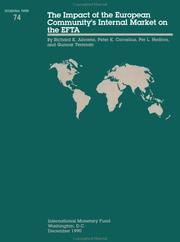| Listing 1 - 2 of 2 |
Sort by
|

ISBN: 1463970382 1463938896 1557751749 Year: 1990 Publisher: Washington, D.C. : International Monetary Fund,
Abstract | Keywords | Export | Availability | Bookmark
 Loading...
Loading...Choose an application
- Reference Manager
- EndNote
- RefWorks (Direct export to RefWorks)
This paper provides an overview of the likely impact of the creation of the European Community (EC) internal market on the European Free Trade Association (EFTA) members. The focus is on the four freedoms and the institutional and legal changes required for increased economic cooperation between the EC and EFTA. Although not formally part of the negotiations, certain tax issues are also raised. The paper is in ten parts and includes a summary and glossary. The paper also discusses the institutional and legal changes that may prove necessary for greater EC-EFTA cooperation and the implications of the internal market for trade, production, and resource allocation in the EFTA countries. It examines issues related to trade in goods-mainly industrial goods-and transport services and considers issues of labor mobility and trade in financial services. Changes would also appear desirable in the areas of industrial and intellectual property rights-notably counterfeiting, trademarks, copyrights, and patents.
Exports and Imports --- Foreign Exchange --- Infrastructure --- Labor --- Taxation --- Industries: Financial Services --- Business Taxes and Subsidies --- Industry Studies: Transportation and Utilities: General --- Financial Aspects of Economic Integration --- Trade Policy --- International Trade Organizations --- International economics --- Labour --- income economics --- Public finance & taxation --- Macroeconomics --- Currency --- Foreign exchange --- Finance --- Transportation --- Monetary unions --- Value-added tax --- Exchange rates --- Labor mobility --- National accounts --- Economic integration --- Taxes --- Financial services --- Saving and investment --- Spendings tax --- Commercial policy --- Iceland
Book
ISBN: 1462375812 1462310222 Year: 1990 Publisher: Washington, D.C. : International Monetary Fund,
Abstract | Keywords | Export | Availability | Bookmark
 Loading...
Loading...Choose an application
- Reference Manager
- EndNote
- RefWorks (Direct export to RefWorks)
This paper discusses various developments and perspectives of the European Monetary System (EMS). There have been three phases in the development of the EMS: from its beginning in March 1979 to March 1983, can be seen as a phase of trial and orientation; from March 1983 to 1987, can be described as one of consolidation; and The Basle/Nyborg agreement marked the end of the consolidation phase, characterized by the striving for stability, the emergence of the deutsche mark as the anchor currency, and the predominance of intramarginal intervention in partner currencies. EMS has allowed simultaneous progress toward external and internal stability. The EMS Agreement provided for fluctuation margins offering some flexibility and for the possibility of central rate changes, which could compensate for diverging monetary policies. As divergences were narrowed, central rate adjustments could be small so as not to affect market rates; thus minimizing the potential for destabilizing capital flows.
Money --- Monetary policy --- Banks and Banking --- Exports and Imports --- Foreign Exchange --- Inflation --- Money and Monetary Policy --- Finance: General --- Labor --- Monetary Systems --- Standards --- Regimes --- Government and the Monetary System --- Payment Systems --- Financial Aspects of Economic Integration --- International Investment --- Long-term Capital Movements --- Banks --- Depository Institutions --- Micro Finance Institutions --- Mortgages --- Price Level --- Deflation --- Wages, Compensation, and Labor Costs: General --- Currency --- Foreign exchange --- International economics --- Monetary economics --- Banking --- Finance --- Macroeconomics --- Labour --- income economics --- Currencies --- Exchange rates --- Monetary unions --- Capital flows --- Economic integration --- Balance of payments --- Exchange rate adjustments --- Exchange rate stability --- Capital movements --- Banks and banking --- International economic integration --- Labor costs --- Germany
| Listing 1 - 2 of 2 |
Sort by
|

 Search
Search Feedback
Feedback About UniCat
About UniCat  Help
Help News
News